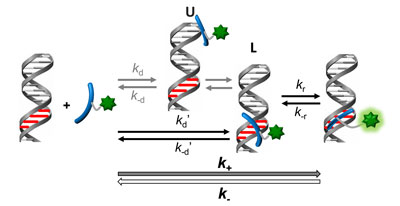Mercedes Novo and Wajih Al-Soufi
During the past decades there has been a great interest in the design of high-affinity, sequence-specific DNA binders interacting either with the major or with the minor groove due to their potential medical applications. Especially relevant are fluorogenic binders that show high detection sensitivity to DNA sequences. This sensitivity depends on the magnitude of the fluorescence increase upon binding and is related to the photophysics of the binder, and to the affinity constant, which in turn is determined by the dynamics of the binding process. Therefore, the progress in the design of DNA binders requires thorough photophysical studies and precise determination of the involved association and the dissociation rate constants.
Our research lines on DNA binders are:
- To search for general mechanisms underlying the binding of small molecules to double-stranded DNA.
- To study the photophysical properties of DNA binders in order to find out the processes responsible for the brightness change upon binding to DNA and improve their properties as markers.
- Determination of the binding affinity and dynamics of sequence-specific DNA-binding ligands for biomedical applications (collaboration with Prof. José Luis Mascareñas and Prof. Eugenio Vázquez, Organic Chemistry Department of the USC).
Single-Molecule Approach to DNA Minor-Groove Association Dynamics
Jorge Bordello, Mateo I. Sánchez, M. Eugenio Vázquez, José L. Mascareñas, Wajih Al-Soufi and Mercedes Novo,
Angewandte Chemie International Edition 2012, 51, 7541–7544
Fluorescence correlation spectroscopy reveals that the dynamics of the association process of the bisbenzamidine minor-groove binder BBA-OG (blue with green star, see scheme) to dsDNA is NOT controlled by diffusion, but by the insertion of the binder into the groove at the specific site (red), as shown by the rate constants for each step of the binding event.
Jorge Bordello, Mateo I. Sánchez, M. Eugenio Vázquez, José L. Mascareñas, Wajih Al-Soufi, and Mercedes Novo
Chemistry - A European Journal, 2015, 21, 1609–1619. DOI: 10.1002/chem.201404926
Insertion of a fluorogenic binder into the minor groove of double-stranded DNA prevents quenching by photoinduced electron transfer and leads to huge fluorescence enhancement (see figure). Fluorescence correlation spectroscopy yields precise dynamic rate constants that help to understand and optimize the specificity and affinity of these binders to DNA.



